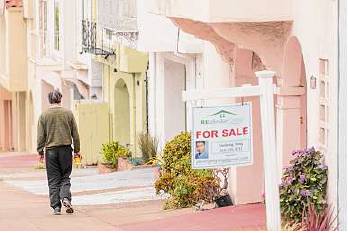Housing market sees big cooldown
High mortgage rates slash competition in Bay Area
By Ricardo Cano
As rising mortgage rates curtail many home buyers’ spending power, home price growth in the Bay Area has slowed, fewer homes are selling above listing price and more sellers are asking for less.
The trends bearing out in the months since average mortgage rates more than doubled — to nearly 7% — contrast the region’s red-hot housing market of 2021, when home prices rose nearly 20% amid stiff competition.
In San Francisco, where the typical home sells for $1.7 million, current listings are staying on the market longer compared with 2021, and yielding fewer offers.
Kevin Birmingham, founder of Park North Real Estate and a past president of the San Francisco Association of Realtors, said sellers could expect to see up to a dozen offers on a home before mortgage rates started climbing in January. And, last year, it was common to see bidding wars between top buyers quickly drive up sale prices — sometimes by upward of $100,000.
“Now, what you’re seeing is one or two offers on a property and nobody willing to really compete against each other,” Birmingham said. “If you’re trying to stretch (buyers) up in price, they’re out. So it’s a very different mentality. And you’re seeing a lot of offer dates come and go ... and no offers even show up.”
In the San Francisco metro area, which includes Oakland and Berkeley, about 60% of homes sold above asking price in August, according to data from real estate listings site Zillow. That figure represents a year-over-year drop of about 20 percentage points and a decline that tracks with the rise in mortgage rates.
Roughly 38% of home listings in the San Jose metro area went above asking price in August, compared with nearly 70% of homes the same month last year. Every other large California metro saw declines in monthly above-asking-price home sales, according to Zillow data.
The percentage of listings with price cuts in metro San Francisco has also increased notably in recent months. As of August, the most recent data available, 1 in 4 home listings saw a price cut, compared with about 12% in August 2021. Sacramento, a popular migration destination for Bay Area residents during the pandemic, had the highest percentage of price-cut listings of any California metro area, at 37%.
Year-over-year price-cut percentages about doubled in metros such as San Jose (25%), Los Angeles (25%) and San Diego (33%) as competition softens.
While surging mortgage rates have cooled demand from last year’s astronomical levels, the Bay Area remains home to some of the most competitive housing markets in the country, partly because of low inventory.
About 53% of metro San Francisco home listings on Redfin attracted a competing bid in August, according to a new report by the real estate listings site. That figure dropped about 20 percentage points from August 2021, when bidding wars ruled the market, though it kept San Francisco in the top 10 most competitive U.S. metros, according to Redfin.
The fast climb in mortgage rates has put many would-be home buyers on the sidelines, thinning competition and giving active buyers more leverage in negotiations. Monthly mortgage payments have gone up by about 33% since the start of the year, making the cost of owning a home even less affordable for prospective buyers.
The Bay Area saw a 29% drop in year-over-year home sales in August, according to the California Association of Realtors. The drop in demand has translated to some price declines.
The region’s sale-to-list ratio has dropped to about 98%, meaning that Bay Area homes on average are selling slightly below asking price, according to Selma Hepp, an economist at the CoreLogic real estate firm.
Though that figure might not appear much different than the Bay Area’s 102% sale-to-list ratio at the start of 2022, “it’s still a significant switch in dynamics from what we saw coming into the first quarter of this year,” Hepp said.
Ricardo Cano is a San Francisco Chronicle staff writer. Email: ricardo.cano@sfchronicle.com
Twitter: @ByRicardoCano
